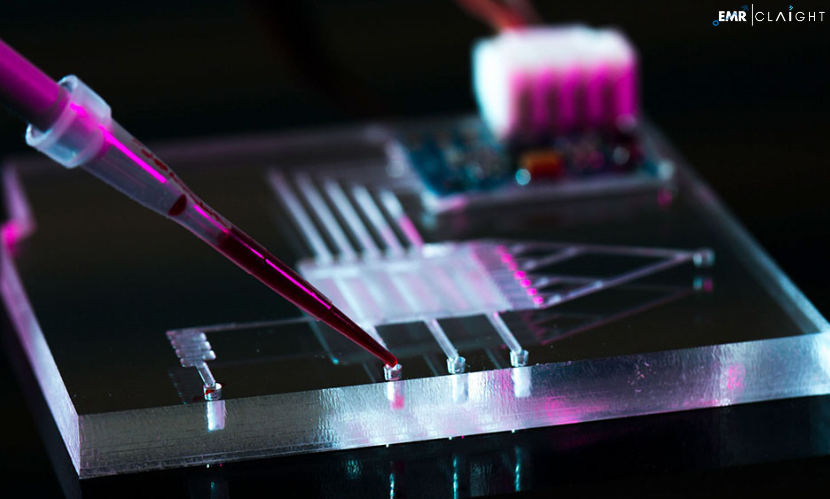Microfluidic device Patent was valued at USD 12.84 billion in 2023. It is expected to grow at a staggering compound annual growth rate (CAGR) of 19.80% during the forecast period of 2024-2032, eventually reaching a market value of USD 65.29 billion by 2032. Microfluidic device technology has revolutionized several industries, particularly drug discovery and diagnostic testing. Its advanced technologies, including microfabrication, have played a pivotal role in shaping the current patent landscape.
Introduction to Microfluidic Devices
Microfluidics refers to the science and technology of systems that process or manipulate small amounts of fluids using channels with dimensions ranging from tens to hundreds of micrometers. Microfluidic devices are often described as “labs on a chip” due to their ability to perform multiple laboratory processes within a single miniaturized setup.
In recent years, these devices have gained immense importance in various sectors, particularly in life sciences and healthcare. From rapid diagnostic testing to drug discovery, microfluidic devices have transformed traditional methods, enabling faster, more precise, and cost-effective solutions. The growth of this market is fueled by technological innovations, expanding applications, and an evolving patent landscape.
Get a Free Sample Report with Table of Contents: https://www.expertmarketresearch.com/patent-analysis/microfluidic-device-patent-landscape/requestsample
Key Market Drivers
Several factors are driving the explosive growth of the microfluidic device market. Some of the primary drivers include:
1. Rising Demand for Point-of-Care Diagnostics
The healthcare industry is increasingly focusing on point-of-care (POC) diagnostics, which allows for rapid, on-site testing. Microfluidic devices, due to their compact size and ability to handle small fluid volumes, are ideal for POC applications. These devices provide faster diagnostic results, particularly in areas like infectious diseases, cancer, and prenatal testing.
2. Innovations in Drug Discovery
The drug discovery process is traditionally time-consuming and expensive. Microfluidic devices have revolutionized this process by allowing pharmaceutical companies to screen drugs more efficiently. By enabling high-throughput screening of compounds, microfluidic technologies accelerate the identification of potential drug candidates, reducing both costs and time-to-market.
3. Technological Advancements in Microfabrication
The advancement of microfabrication technologies has enabled the development of more sophisticated microfluidic devices. These technologies facilitate the creation of intricate channels and structures within the devices, improving their functionality and efficiency. This is particularly important in applications like DNA sequencing and cell analysis, where precision is paramount.
4. Growing Adoption in Healthcare and Biotechnology
The expanding applications of microfluidic devices in sectors such as healthcare, biotechnology, and life sciences are driving market growth. From cell manipulation and molecular biology to organ-on-chip models and personalized medicine, microfluidics is playing an increasingly central role in advanced research and therapeutic development.
Read Full Report with Table of Contents: https://www.expertmarketresearch.com/patent-analysis/microfluidic-device-patent-landscape
Trends Shaping the Microfluidic Device Market
The microfluidic device market is undergoing rapid changes, driven by new trends and innovations. Some of the most notable trends include:
1. Integration of Artificial Intelligence (AI) and Automation
AI and automation are increasingly being integrated with microfluidic systems. By utilizing AI algorithms, microfluidic devices can analyze data more efficiently and provide more accurate diagnostic results. Additionally, automated systems enable continuous monitoring and control of fluid movement, leading to greater precision and repeatability in experiments.
2. Personalized Medicine and Organ-on-Chip Models
Personalized medicine, where treatments are tailored to an individual’s unique genetic profile, is a growing trend in the healthcare industry. Microfluidic devices, particularly organ-on-chip models, are being used to simulate human organs in vitro, allowing researchers to study disease progression and test drug efficacy in a controlled environment. These devices are revolutionizing the development of personalized therapies and are expected to drive further innovation in the microfluidics market.
3. Lab-on-a-Chip Technology for Disease Diagnosis
Lab-on-a-chip technology, which incorporates multiple laboratory functions onto a single chip, is revolutionizing disease diagnosis. These devices allow for the rapid detection of diseases such as cancer, HIV, and tuberculosis. As healthcare systems worldwide aim to improve early disease detection, the adoption of lab-on-a-chip technology is expected to soar.
4. 3D Printing in Microfluidic Device Manufacturing
3D printing technology is gaining traction in the development of microfluidic devices. By using 3D printing, manufacturers can create more complex and customized microfluidic systems at a lower cost. This method allows for greater flexibility in device design and rapid prototyping, which can accelerate the development of new microfluidic applications.
Patent Landscape and Innovation in Microfluidics
The surge in technological advancements has led to a significant increase in patent applications related to microfluidic devices. This evolving patent landscape reflects the innovations that are taking place in the industry.
1. Microfabrication Techniques
A large portion of the patents filed in the microfluidics market focuses on novel microfabrication techniques. These techniques are essential for creating high-precision channels and structures within microfluidic devices. Innovations in materials used for microfabrication, such as silicon, glass, and polymers, have enabled the creation of more efficient and durable devices.
2. Integration with Biosensors
Many patent applications focus on the integration of microfluidic devices with biosensors. Biosensors allow for the detection of specific biological markers, making these devices invaluable in diagnostic testing. Innovations in this area include the development of real-time biosensor technologies that can provide immediate results, further enhancing the utility of microfluidic devices in healthcare.
3. Patents Related to Organ-on-Chip Systems
As organ-on-chip technology becomes more widespread, patents related to these systems are increasing. Researchers and companies are filing patents for specific organ models, such as liver-on-chip or heart-on-chip devices, which mimic the functions of human organs. These devices are crucial for drug testing and understanding disease mechanisms, and the growing number of patents in this space highlights the industry’s shift toward more advanced applications.
Market Segmentation: A Comprehensive Overview
The microfluidic device market is highly segmented based on technology, application, material, and region. Understanding the segmentation provides deeper insights into the areas of growth and innovation.
1. By Technology
- Microfluidic Chips: These chips are used in applications like DNA analysis, cell sorting, and chemical synthesis.
- Micro Pumps: Essential for fluid control within the microchannels, these pumps are widely used in drug delivery and diagnostics.
- Micro Valves: Used for controlling fluid flow, micro valves are essential components in lab-on-a-chip devices.
- Others: This includes technologies such as micro needles, micro mixers, and micro reactors.
2. By Application
- Healthcare and Diagnostics: Includes applications such as disease diagnosis, prenatal testing, and infectious disease testing.
- Drug Discovery and Development: Microfluidic devices are widely used in high-throughput drug screening and toxicity testing.
- Environmental Monitoring: Microfluidics is used for monitoring water and air quality, particularly in detecting pollutants and pathogens.
- Food and Agriculture: These devices are used for testing food safety and quality, as well as in agricultural research.
- Others: Includes industrial applications like inkjet printing and chemical synthesis.
3. By Material
- Silicon: Offers excellent mechanical strength and is widely used in microfabrication.
- Polymers: Cost-effective and versatile, polymers like PDMS are popular for creating flexible microfluidic devices.
- Glass: Provides high chemical resistance and optical transparency, making it ideal for applications that require precise fluid handling.
- Others: Includes materials like ceramics and metals, used in specialized applications.
4. By Region
- North America: The largest market due to its advanced healthcare infrastructure and significant investments in R&D.
- Europe: Home to several leading biotechnology companies, Europe is another key region for microfluidic device adoption.
- Asia Pacific: Rapidly growing due to increased healthcare spending and the presence of manufacturing hubs in countries like China and India.
- Latin America and Middle East & Africa: These regions are expected to experience slower growth but present untapped opportunities in the coming years.
Recent Developments in the Microfluidic Device Market
Recent advancements in the microfluidic device market have focused on improving device functionality, increasing automation, and expanding applications in emerging fields.
1. Advancements in Bioprinting
Bioprinting is one of the most exciting developments in the microfluidics industry. Researchers are now using bioprinting techniques to create microfluidic devices that can print living cells. This advancement is expected to play a significant role in tissue engineering and regenerative medicine.
2. Expansion of Organ-on-Chip Models
The development of more complex organ-on-chip models is accelerating, with researchers now focusing on multi-organ systems that can mimic entire human physiological systems. These developments are expected to reduce the need for animal testing and improve the drug development process.
3. Miniaturization of Lab-on-a-Chip Devices
One of the key trends is the continued miniaturization of lab-on-a-chip devices. These devices are becoming more compact, portable, and easier to use, making them ideal for point-of-care applications in remote or resource-limited settings.
COVID-19 Impact on the Microfluidic Device Market
The COVID-19 pandemic has had a profound impact on the microfluidic device market, particularly in the areas of diagnostic testing and drug discovery. As the need for rapid and accurate testing increased during the pandemic, microfluidic devices became indispensable tools for detecting the virus.
1. Increased Demand for Diagnostic Testing
Microfluidic devices were used extensively for COVID-19 testing, providing faster and more accurate results compared to traditional methods. This surge in demand is expected to have a lasting impact on the market, as the healthcare industry continues to focus on rapid diagnostic solutions.
2. Acceleration of Drug Development
The pandemic accelerated the drug development process, with pharmaceutical companies turning to microfluidic devices to screen potential treatments and vaccines for COVID-19. This has spurred innovation in the industry and is likely to drive further growth in the coming years.
Key Players in the Microfluidic Device Market
Several companies are leading the way in the development and commercialization of microfluidic devices. Key players include:
- Danaher Corporation: Known for its diagnostic technologies, Danaher has made significant advancements in lab-on-a-chip and POC diagnostic devices.
- Thermo Fisher Scientific: A global leader in scientific research, Thermo Fisher has developed a range of microfluidic solutions for drug discovery and diagnostics.
- PerkinElmer Inc.: PerkinElmer specializes in diagnostic testing technologies and has developed innovative microfluidic devices for use in healthcare.
- Bio-Rad Laboratories: Known for its contributions to life sciences research, Bio-Rad has a strong presence in the microfluidics market, particularly in the field of cell analysis.
About Us
Acquire unparalleled access to critical industry insights with our comprehensive market research reports, meticulously prepared by a team of seasoned experts. These reports are designed to equip decision-makers with an in-depth understanding of prevailing market trends, competitive landscapes, and growth opportunities.
Our high-quality, data-driven analysis provides the essential framework for organisations seeking to make informed and strategic decisions in an increasingly complex and rapidly evolving business environment. By investing in our market research reports, you can ensure your organisation remains agile, proactive, and poised for success in today’s competitive market.
Don’t miss the opportunity to elevate your business intelligence and strengthen your strategic planning. Secure your organisation’s future success by acquiring one of our Expert Market Research reports today.
Media Contact
Company Name: Claight Corporation
Contact Person: James william, Corporate Sales Specialist
Email: sales@expertmarketresearch.com
Toll Free Number: +1-415-325-5166 | +44-702-402-5790
Address: 30 North Gould Street, Sheridan, WY 82801, USA
Website: www.expertmarketresearch.com
Related Trending Reports
https://www.expertmarketresearch.com/reports/cell-lysis-and-disruption-market
https://www.expertmarketresearch.com/reports/genetic-cardiomyopathies-market
https://www.expertmarketresearch.com/reports/irritable-bowel-syndrome-treatment-market




